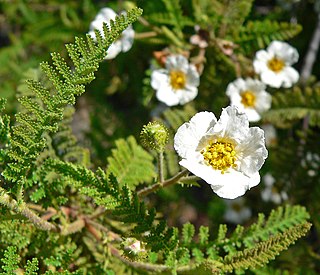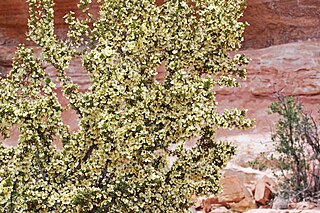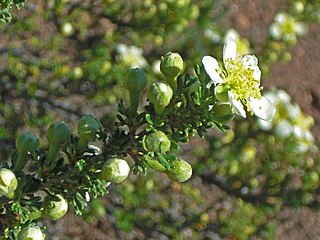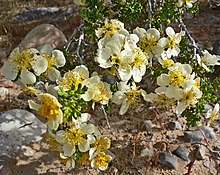
Rosaceae, the rose family, is a medium-sized family of flowering plants that includes 4,828 known species in 91 genera.

The rose subfamily Rosoideae consists of more than 850 species, including many shrubs, perennial herbs, and fruit plants such as strawberries and brambles. Only a few are annual herbs.

Dryas is a genus of perennial cushion-forming evergreen dwarf shrubs in the family Rosaceae, native to the arctic and alpine regions of Europe, Asia and North America. The genus is named after the dryads, the tree nymphs of ancient Greek mythology. The classification of Dryas within the Rosaceae has been unclear. The genus was formerly placed in the subfamily Rosoideae, but is now placed in subfamily Dryadoideae.

Cercocarpus, commonly known as mountain mahogany, is a small genus of at least nine species of nitrogen-fixing flowering plants in the rose family, Rosaceae. They are native to the western United States and northern Mexico, where they grow in chaparral and semidesert habitats and climates, often at high altitudes. Several are found in the California chaparral and woodlands ecoregion.

Purshia tridentata, with the common name bitterbrush, is a shrub in the genus Purshia of the family Rosaceae. It is native to mountainous areas of western North America.

Shrub-steppe is a type of low-rainfall natural grassland. While arid, shrub-steppes have sufficient moisture to support a cover of perennial grasses or shrubs, a feature which distinguishes them from deserts.

Sibbaldiopsis is a genus in the plant family Rosaceae. This genus only contains a single species: Sibbaldiopsis tridentata, formerly Potentilla tridentata. Commonly, its names include three-toothed cinquefoil, shrubby fivefingers, and wineleaf. Systemic phylogenetic work has placed S. tridentata within Sibbaldia as Sibbaldia retusa.

Chamaebatia, also known as mountain misery, is a genus of two species of aromatic evergreen shrubs endemic to California. Its English common name derives from early settlers' experience with the plant's dense tangle and sticky, strong-smelling resin. They are actinorhizal, non-legumes capable of nitrogen fixation through symbiosis with the actinobacterium, Frankia.

The subfamily Dryadoideae consists of four genera in the family Rosaceae, all of which contain representative species with root nodules that host the nitrogen-fixing bacterium Frankia. They are subshrubs, shrubs, or small trees with a base chromosome number of 9, whose fruits are either an achene or an aggregate of achenes.

Pinyon–juniper woodland, also spelled piñon–juniper woodland, is a biome found mid-elevations in arid regions of the Western United States, characterized by being an open forest dominated by low, bushy, evergreen junipers, pinyon pines, and their associates which vary from region to region. At lower elevations, junipers often predominate and trees are spaced widely, bordering on and mingling with grassland or shrubland, but as elevation increases, pinyon pines become common and trees grow closer, forming denser canopies. Historically, pinyon-juniper woodland has provided a vital source of fuel and food for peoples of the American Southwest. These nuts have also provided a crucial source of food for species such as the Pinyon jay, which have become threatened as landowners have historically tried to convert large areas of pinyon-juniper woodland to grazing lands.

Sieversia is a genus of flowering plants of the family Rosaceae. It is also in the subfamily Rosoideae, and tribe Colurieae.

Purshia stansburyana is a species of flowering plant in the rose family known by the common name Stansbury's cliffrose. It is native to the southwestern United States and northern Mexico, where it grows in woodlands, desert, and plateau habitat. It often grows anchored on cliffs and prefers rocky, granular soils, especially limestone.

Purshia mexicana is a species of perennial flowering small tree in the rose family known by the common name Mexican cliffrose. It is native to western-northern Mexico, the region of the Sierra Madre Occidental cordillera.

Fendlera rupicola, commonly known as the cliff fendlerbush or the false mockorange, is a shrub that grows in dry locations in the south central mountain regions of North America.

Purshia glandulosa is a species of flowering plant in the rose family known by the common names antelope bitterbrush, desert bitterbrush, Mojave antelope brush, and cliff-rose.
Chrysothamnus molestus is a species of flowering plant in the family Asteraceae known by the common names Arizona rabbitbrush, Tusayan rabbitbrush, disturbed rabbitbrush, and stickyfruit low rabbitbrush. It is endemic to the State of Arizona in the southwestern United States, where it is known from Coconino, Apache, and Navajo Counties.
Callophrys fotis is a species of butterfly in the family Lycaenidae, the gossamer-winged butterflies. It is known by several common names, including early elfin, desert elfin, Fotis hairstreak, Strecker's elfin, and Arizona gray elfin. It is native to the southwestern United States, where it occurs in southeastern California, Nevada, Utah, western Colorado, northern Arizona, and northwestern New Mexico.

Cercocarpus breviflorus, commonly known as desert mountain mahogany or hairy mountain mahogany, is a species of plant in the rose family, native to northern Mexico and the southwestern United States.

Sibbaldia is a genus of flowering plants of the family Rosaceae, with a circumpolar distribution, including the high Arctic. Most of the species are found in the Himalaya. The type species is Sibbaldia procumbens. It is also in the Rosoideae subfamily.




















